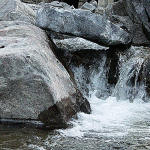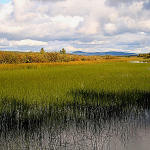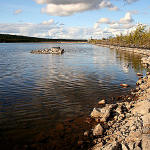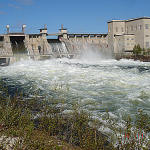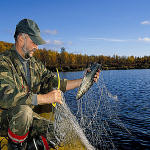

Home
Area
Vätsäri
Övre Pasvik
Pasvik Zapovednik
Nature
Geology
Climate
Water system
Flora
Fauna
Culture
Population
Religion
Sources of livelihood
Old ways of life
Time of industrialism
History
Stone Age
Early Metal Age
Late Metal Age
Middle Ages
Towards modern times
Timeline
Cooperation
Nature monitoring
Nature tourism
Publications
Contacts
Visit Pasvik-Inari
Guidelines
Regulations
News
Links
Water system
A route through the wilderness
The catchment area of Pasvik River is wide. Most of the streams in Vätsäri flow into Lake Inari and end up in Pasvik River. The distance from the headwaters of the River Ivalo, which flows into Lake Inari, to Bøkfjorden at the Barents Sea is 380 km. The river has been a source of living for the inhabitants of the valley. Fishing and waterfowl hunting have been important sources of livelihood and the grasslands on the shore have been pastured and mowed. The river formed also an important transportation route to the market places close to Barents Sea. During the great loggings in the 1920s the logs were floated to saw-mills in Elvenes and Jakobsnes by the outlet of the Pasvik River.
Lures, nets and trawls in use
The fishing is practised both for living and for leisure. Today, the most important catch in the Lake Inari is whitefish (Coregonus sp), although plenty of vendace (Coregonus albula) is also caught. The vendace became accidentally naturalised in the lake, and became so abundant that trawls were used to catch the fish. This proved to not to be profitable in the long run. The whitefish is caught also from Pasvik River, where, in addition, pike (Esox lucius) and perch (Perca fluviatilis) are important catches. Trout (Salmo trutta) is a well respected catch of the small streams.
Disappearing grasslands
Melting the nickel from Pechenga in a factory at the Kolos River needed great amount of energy. Jäniskoski rapid was harnessed already in 1942. This first hydroelectric plant was bombed by the German troops withdrawing from Pechenga in 1944. New hydroelectric plants were built after the war and seven plants altogether have been built along Pasvik River.
The regulation of the waters has brought changes to the area. The river flows more slowly and causes overgrowth in the shallow areas. Flooding has been prevented and the vegetation on the shores is in danger because of the damming and earthmoving. The disappearance of the grasslands on the shore shrinks the habitats typical of several plant species. For example the bluntleaf sandwort (Moehringia lateriflora) has vanished from the shores.
In Lake Inari, the regulation changed the natural rhythm of the change in water level. Now the water level is highest during the autumn and is lower during the winter. The water level is very low when the ice starts to melt during the spring. In shallow waters the ice stuck in the bottom destroys vegetation and harms the fauna, for example the reproduction of those fish that spawn in the autumn. Due to the regulation of the waters the highest water level is half a meter higher than naturally.
Changes in fauna
Regulation has affected the fauna in several ways. The stations block fish migration, and therefore the local fish populations have been formed between the stations. In addition, the river flows more slowly which has caused overgrowth on the shallow areas. The fish thriving in the rapidly flowing water, such as brown trout (Salmo trutta) and grayling (Thymallus thymallus) have suffered from the changes in the aquatic environment while pike, perch and whitefish have benefited from it. The fish in Lake Inari were affected by the regulation so strongly that fish needed to be planted in the lake. Such planted species were lake trout (Salvelinus namaycush), muksun (Coregonus muksun) and vendace (Coregonus albula).
Other animals have also been affected by the changes. The otter (Lutra lutra) has not been seen for years. The Pasvik River and the surrounding wetlands comprise an important habitat for several bird species. The changes in the environment are reflected by the changes in the bird fauna. White-throated dipper (Cinclus cinclus) for instance, is rarely seen today. The regulation of Lake Inari has presumably affected nesting of the Black-throated Diver (Gavia arctica). When the water level rises towards the end of summer, the nests drown under water.
